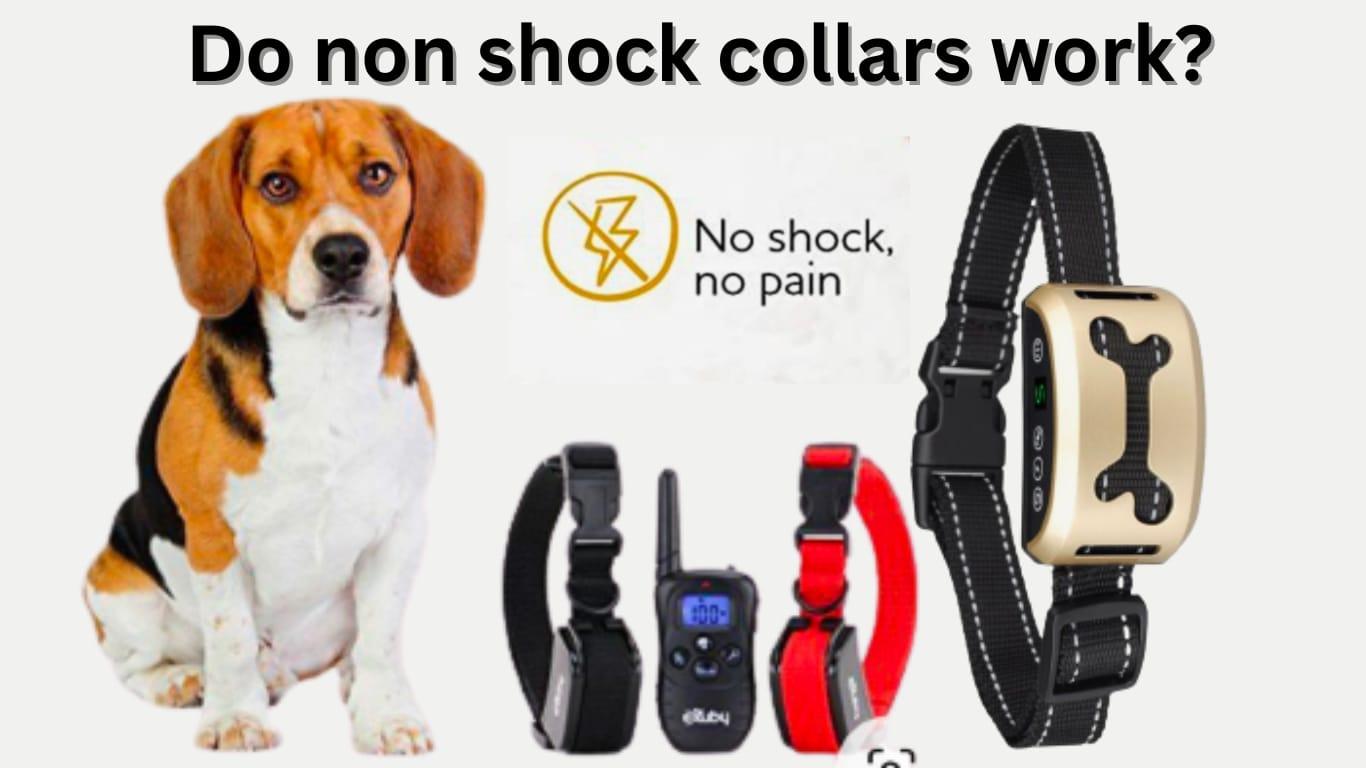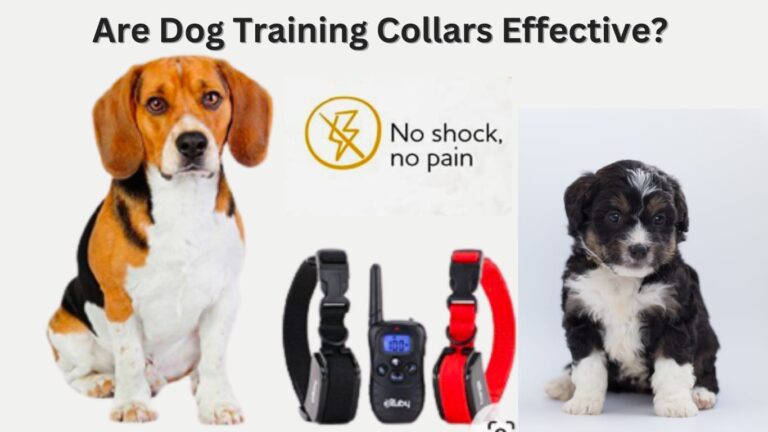Do non shock collars work?

Do non shock collars work?
Non-shock collars, often referred to as training or behavior modification collars, are specially crafted to manage a dog’s conduct without causing any harm or discomfort through electric shocks. These collars employ diverse techniques to interact with your pet and instruct them on better behavior.
Now, let’s find out the answer to this essential question: “Do non-shock collars work?” The answer is Yes, non-shock collars can indeed be effective tools in training dogs to improve their behavior.
Do non shock collars work? Exploring the Effectiveness of Non-Shock Collars:
Non-shock collars mainly operate through three key mechanisms: sound, vibration, and spray. In the case of sound, the collar emits a beep or tone when your dog does something unwanted, like barking excessively or pulling on the leash. The beep acts as a signal to let your pet know that their behavior is not desired. Vibration collars provide a gentle buzz to get your dog’s attention, and spray collars release a harmless mist, often scented, to deter certain behaviors. These methods aim to disrupt your dog’s actions and redirect their focus.
Many pet owners find non-shock collars to be effective in addressing common behavioral issues. These collars can assist in teaching your dog commands, discouraging excessive barking, and curbing unwanted behaviors like jumping or digging. Positive reinforcement, like treats and praise, is often combined with these collars to reinforce good behavior. It’s essential to remember that patience and consistency play crucial roles in successful training.
Nonetheless, it’s essential to understand that no one-size-fits-all solution exists for dog training. The effectiveness of non-shock collars can vary depending on the dog’s temperament, the specific behavioral problem you’re trying to address, and your commitment to training. Some dogs may respond better to these collars than others, and it’s essential to consult with a professional trainer or veterinarian to determine the best approach for your pet. While non-shock collars can be a valuable tool, they should always be used in conjunction with positive reinforcement and humane training techniques to ensure your dog’s well-being and happiness.
Let’s explain the effectiveness of non-shock collars:
Non-shock collars can be effective tools for training and behavior modification, offering gentle alternatives to electric shock collars. They rely on sound, vibration, or spray to communicate with your dog and redirect their actions. However, their effectiveness may vary, and they should be used in conjunction with positive reinforcement and under professional guidance. The key to success lies in understanding your dog’s unique needs and using these collars as part of a comprehensive training strategy.
Positive Training Methods
Positive training is a friendly way to teach dogs. It means rewarding them when they do things right, like giving them treats or saying nice things. Non-shock collars are useful because they can help with this training. For example, if your dog listens to you and behaves well, the collar might make a nice sound. Your dog learns that good behavior makes good things happen.
This kind of training helps dogs like you and builds trust between you and your pet. When they know that good behavior gets them treats and love, they want to do it again. So, it’s not about scaring or hurting them, but about making them happy to be good.
Behavioral Modification
Behavioral modification means changing how your dog acts. Non-shock collars can help with this too. Let’s say your dog barks a lot or pulls on the leash too hard. The collar can help with that. When your dog does something you don’t like, the collar might make a sound or a small buzz to get their attention. This reminds them to stop doing the bad thing.
Over time, your dog learns that when they do these things, they hear the sound or feel the buzz, so they stop doing it. It’s like a gentle way of telling them what’s right without hurting them. This can be really helpful if you want your dog to behave better.
So, non-shock collars are good because they make training your dog easier and nicer. They reward good behavior and gently remind them when they do something not so good. It’s like having a helpful friend to teach your dog how to be their best.
Benefits and Drawbacks
Non-shock collars have their good sides and not-so-good sides. Let’s see what they are.
Advantages of Non-Shock Collars
Non-shock collars are like your dog’s friendly teacher. They help with training by making good behavior fun. When your dog behaves well, these collars might give them treats or make nice sounds. The good thing is, they don’t hurt your dog. So, your dog learns to be good while staying happy.
Limitations and Concerns
But, these collars aren’t magical. Some dogs might not listen to them, or they might not work for all problems. Also, you need to use them the right way, or they won’t help. Plus, not all dogs like wearing them, so you need to be careful.
Factors to Consider
When you want to use a non-shock collar, think about these things:
Choosing the Right Collar
There are many types of these collars, like the ones that make sounds or vibrations. Choose the one that matches your dog’s problem and your training style.
Training Techniques
Using the collar is just one part of training. You also need to be patient and teach your dog what’s right. Give them treats and love when they do good things.
Comparison with Shock Collars
Some people use shock collars, which can hurt dogs. Non-shock collars are a kinder way to teach dogs. We’ll talk about how they’re different.
Ethical Considerations
Being nice to your dog is important. Non-shock collars are better for your dog’s happiness and health. We’ll explain why.
Tips for Effective Use
To make the collar work, follow these tips:
Training Tips: Be patient and teach your dog with love.
Safety Precautions: Make sure your dog is comfortable and safe when using the collar.
Are No-Shock Collars Effective?
No-shock collars are designed to help train dogs without using electric shocks. Many people find them helpful, but their effectiveness can depend on a few factors.
- Positive Training: No-shock collars often use positive methods like beeping sounds, gentle vibrations, or sprays to guide your dog. These methods can be effective for teaching basic commands and discouraging unwanted behaviors.
- Training Goals: The effectiveness of no-shock collars can vary based on what you’re trying to teach your dog. They tend to work well for behaviors like excessive barking or pulling on the leash, but they might not be as effective for more complex issues.
- Consistency and Patience: Like any training method, using no-shock collars requires consistency and patience. You need to use them correctly and regularly for your dog to understand what you want.
- Individual Dogs: Every dog is unique. Some dogs respond really well to no-shock collars, while others may not. It’s essential to consider your dog’s personality and needs when deciding if these collars are right for you.
Non-shock collars can be effective tools for training, especially for common behavior problems. However, their success depends on how they’re used and your dog’s specific traits. It’s essential to combine collar training with positive reinforcement and to be patient and consistent in your efforts to see the best results.
Conclusion
Summing it all up, non-shock collars are a friendly way to help your dog behave better. They reward good behavior and gently remind your dog when they do something not so good. Remember to be kind and patient when using them.
You can also read this: Is A Shock Collar Bad For Dogs?





